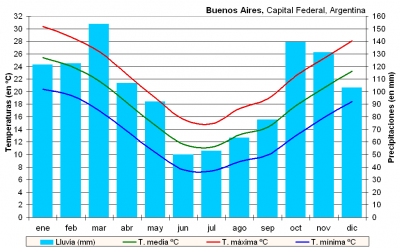El climate of the city of Buenos Aires es warm wet. In recent years there has been an increase in temperatures due to factors such as the height of the buildings and a lot of asphalt. The annual averages are 18ºC, although peaks of 40ºC and 0ºC have been registered sporadically.
The days of Covered sky are very frequent in winter, but it rains more in summer, when very intense storms develop and a lot of water falls in a short time. In winters, days of persistent weak drizzle known as "drizzle".
The Summers They are warm, with average temperatures of 24,5ºC in January and the high humidity is suffocating. The noon hours are very hot, but at night it tends to cool down somewhat.
The winters They are mild, with average temperatures of 10ºC in July and frequent fogs that cover the city. They are not rainy but the skies are covered many days and the high humidity (up to 95%) increases the feeling of cold. The days are nice but at night the temperature drops a lot.
The winds that blow are the Pampero, which comes from the central pampa, carrying dry air that refreshes the city, and the Sudestada, especially in Fall and Spring, which provides humidity, rains and floods of the Río de la Plata that can cause floods.
The last few years have been recorded sleet mild that are infrequent and originate in Antarctic polar fronts. Usually hail in late winter and early spring. But the protagonist of the meteorological reports is the moisture, which modifies the thermal sensation, increasing the sensation of extreme temperatures in each season.
This article has been shared 35 times. We have spent many hours collecting this information. If you liked it, share it, please:




